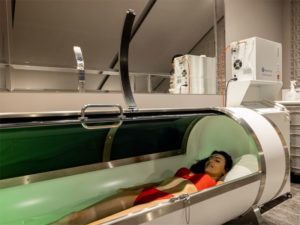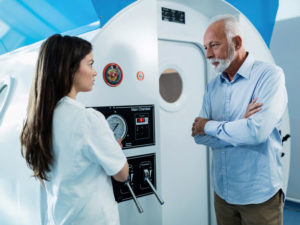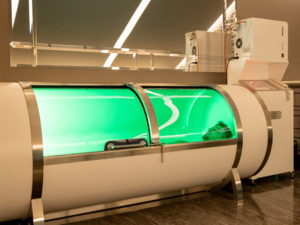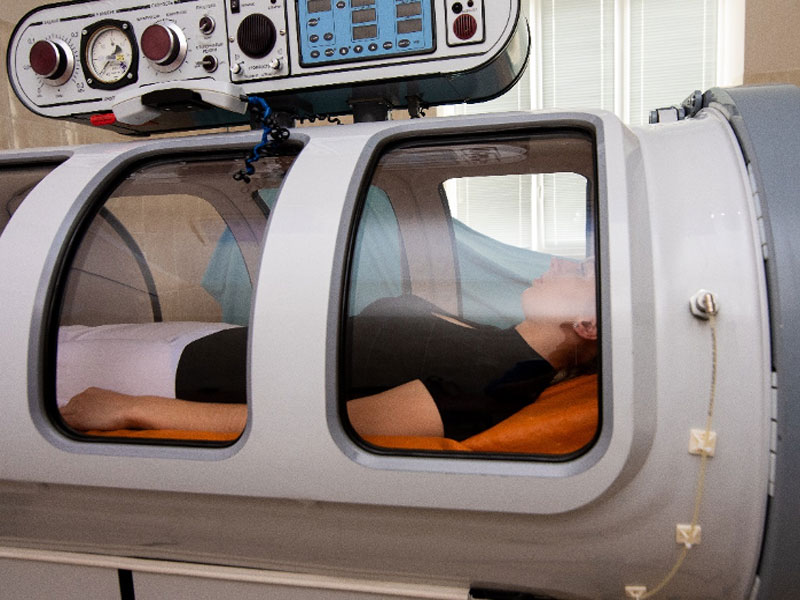
What if there were a way to address health conditions and promote healing from the inside out just by breathing pure oxygen? That’s exactly what hyperbaric oxygen therapy (HBOT) does.
Hyperbaric oxygen therapy has become quite popular over the years, and there’s a good reason.
Although it was first conceived for undersea and hyperbaric medicine, this simple, non-invasive, and non-chemical treatment has now progressed to treating other medical conditions.
These include slow-healing and non-healing wounds – something you may have experienced.
In these cases, hyperbaric oxygen therapy works for you by improving your body’s function and triggering the healing process through delivering a concentration of oxygen.
Curious to know if you, too, could benefit from breathing pressurized oxygen?
We’ve got you covered. Keep reading to discover everything about hyperbaric oxygen therapy. From indications for using it, to possible side effects, here’s everything you need to know to make your best decision.
What is Hyperbaric Oxygen Therapy?
What Conditions Can and Cannot Be Treated with Hyperbaric Oxygen Therapy?
What Can You Expect from This Medical Treatment?
Risks and Possible Side Effects of Hyperbaric Oxygen Therapy
What is Hyperbaric Oxygen Therapy?
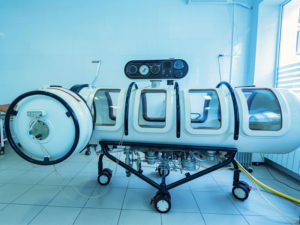
Simply put, it’s a treatment in which you sit comfortably or lie down in a hyperbaric chamber to breathe 100% pure oxygen(you may not know it but the air we naturally breathe has an oxygen concentration of only 21%!).
In addition, the pure air is pressurized – with levels 1.5 to 3 times higher than normal air pressure. This high pressure increases the amount of oxygen in your blood.
But is this good for your health?
It’s helpful and healthy, yes. Let’s look why.
Your body’s cells and tissues need oxygen to function correctly. In normal conditions, your blood carries sufficient oxygen from your lungs to your cells and healthy tissue. But if something goes wrong, and you suffer an injury, it affects the functioning of your whole body.
With a chronic wound or injury, your blood vessels get damaged, causing swelling. The swelling prevents enough oxygen reaching the damaged cells. And when the cells lack oxygen, they can’t produce enough energy.
But they need energy to fight bacteria or to perform any reparative function, such as taking nutrients in or sending waste out. So, lack of energy slows down your healing process.
And that’s where hyperbaric oxygen therapy comes in handy!
HBOT increases the oxygen level in your bloodstream while triggering the production of new blood vessels. By supplying more oxygen to your blood, HBOT interrupts the cycle of swelling > oxygen lack > tissue death – and restores your sick cells, which, in turn, speeds up wound healing.
But the benefits don’t end there.
As you know, red blood cells carry oxygen throughout your bloodstream. On the other hand, white blood cells create antibodies to keep your immune system up and running, protecting you from viruses, bacteria, and disease.
With the extra oxygen supply from HBOT, your white blood cells can
- reduce swelling and
- trigger the fast reproduction of new blood vessels.
This accelerates your recovery and allows your body to heal properly.
In addition, oxygen therapy also promotes the release of growth factors and stem cells, which are essential for healing.
What Conditions Can and Cannot Be Treated with Hyperbaric Oxygen Therapy?
Hyperbaric oxygen therapy was invented in the 1930s to treat decompression sickness – also called gas embolism or “the bends.”
This condition happens when air bubbles expand in the body. It can be life-threatening if not treated within hours. In this context, HBOT has successfully saved the lives of many US Navy deep-sea divers.
However, as years passed and research evolved, doctors discovered that hyperbaric medicine could also be used to effectively treat various medical conditions – from anemia to diabetic foot wounds.
Currently, the US Food and Drug Administration (FDA) has approved the use of hyperbaric oxygen therapy to treat the following 13 health conditions:
- Carbon monoxide poisoning
- Decompression illness (DCI)
- Brain and sinus infections
- Air or gas embolism
- Anemia due to severe bleeding
- Burns from heat or fire
- Crush injuries
- Necrotizing soft tissue infections – due to poor circulation or diabetic non-healing wounds
- Gas gangrene
- Bone marrow infection
- Skin grafts and flaps that are not healing well
- Low blood flow in arteries
- Radiation injury due to cancer treatment
In addition to the conditions above, there are calls for approval of HBOT as an alternative way to treat the following health issues:
- Stroke recovery
- Chronic fatigue syndrome
- Chronic obstructive pulmonary disease (COPD)
- Migraine headaches
- Injury recovery
- Fibromyalgia
- Post-op recovery
- Immune deficiency
- Post-workout fatigue
- Autism
- Attention deficit hyperactivity disorder (ADHD)
- Chronic wounds and pain
- COVID-19
However, the FDA hasn’t yet approved use for any other condition beyond the 13 we listed first. They also state that HBOT is NOT considered safe or effective for treating some specific health problems, including:
- HIV
- Brain injury
- Asthma
What Can You Expect from This Medical Treatment?
Two ways of receiving HBO therapy
1 In a monoplace chamber: individualized treatment in which the patient lies down in a clear plastic tube and breathes. (The pressurized chamber looks like an MRI machine!)
2 In a multiperson room: a room in a healthcare facility where two or more people sit or lie down in different chairs to receive treatment with a mask or a hood placed over the head.
Regardless of the chamber type, the treatment is equally effective and painless. All you need to do is breathe – it’s as easy as that!
Each session may last from one to two hours, and you can use this time to relax, read a book, or even sleep.
Some people report a temporary feeling of fullness in the ears due to the high pressure – like you can experience on a plane. You can quickly relieve this by yawning, swallowing, or chewing gum.
During and after treatment, your Nava practitioner or healthcare team member will monitor you, and you can even chat with them or ask questions about your treatment.
How many sessions do you need for HBOT?
The number and duration of HBO treatments you need depend on your medical history and the condition you’re trying to treat.
Your doctor will first require some tests to check the oxygen level in your blood before prescribing the most suitable protocol to meet your health needs.
Protocols can vary widely, and your certified physician will develop an individualized treatment plan that may also combine other therapies and medicines into your HBOT schedule for optimal results.
For example, if you’re seeking HBOT for diabetic wound care or a skin graft, you may get daily sessions for a month.
On the other hand, three visits may be enough if you’re seeking treatment for carbon monoxide poisoning.
Results from hyperbaric oxygen therapy
Suppose you suffer from a wound that doesn’t heal naturally due to, for example, crush injury or radiation therapy. In that case, HBOT treatment may save you from losing a limb or literally save your life!
That’s how big an impact this kind of treatment can have on improving your health.
And doctors are only just beginning to discover all the possible positive outcomes. As research evolves, doctors may be able to treat more and more conditions with this simple and highly effective therapy.
For example, in the recent pandemic, some Long Covid-19 patients found their brain fog and cognitive damage improved after hyperbaric oxygen treatment.
The most significant result of HBO therapy, however, is
- a substantial decrease in wound healing time and
- the lowered risk of serious infections and complications due to that delayed wound healing.
And sometimes, your immune system needs a booster or a little help repairing tissues for recovery. And that booster may be as easy as breathing via hyperbaric therapy.
In short, pressurized, pure oxygen in the blood
- triggers your body’s healing abilities,
- accelerates recovery, and
- avoids further severe complications.
It’s a no-brainer if you find you’re a good fit for treatment.
So, let’s look at that next.
Is HBOT for Everyone?
No. It’s hard to say that to you when you’ve read this far. But there are some contra-indications for receiving this treatment. We’ll give it to you straight.
You shouldn’t get hyperbaric oxygen treatment if:
- You’ve had recent ear surgery or injury.
- You have a fever, flu, or a cold.
- You suffer from a lung disease or lung failure.
- You use insulin to treat diabetes (diabetic patients may receive treatment for diabetic wounds, but they should be carefully supervised, as the treatment may lower blood sugar levels).
Your certified physician or healthcare provider should check your medical history before prescribing hyperbaric oxygen therapy. So – always tell your doctor about any health condition you might have or any medication you may be taking before starting your treatment.
Risks and Possible Side Effects of Hyperbaric Oxygen Therapy
As with any medical procedure, there are some possible side effects associated with this treatment.
They’re usually mild and may include:
- Fatigue
- Nausea
- Headache
- Claustrophobia
- Dizziness
- Anxiety
Serious risks or adverse events are rare, but it’s worth noting that too much oxygen can also cause damage to your body, leading to complications in your ears, eyes, or lungs.
The most serious risks may include the following:
- Trauma or damage in your middle ear, including eardrum rupture due to air pressure
- Oxygen toxicity, which may be life-threatening or may cause seizures, convulsions, and fluid in your lungs
- Lung collapse or failure
- Eye damage, including vision changes and cataracts
- Increase in your blood pressure
- Hypoglycemia or low blood sugar
- Pain or injury to your teeth and sinuses
And a word of commonsense warning: Pure oxygenis highly flammable, so for your safety, and to avoid any risk of fire, you should leave behind matches, lighters, or anything that could spark a fire!
Ready to Give Hyperbaric Oxygen Therapya Shot?
If you’ve read this far, you may have one of the treatable conditions we’ve mentioned above – or know someone else who has.
Maybe that’schronic non-healing wounds – which leaves them open to infection. Or maybe skin grafts and skin flaps, or injuries from radiation therapy, etc.
Whatever it is, we hope we’ve shown you all you need to know to decide that HBOT may be just what would deliver enough pure, pressurized oxygento your blood to support
- your immune system,
- wound healing, and
- overall health.
You Can Count on Us to Help You
At Nava Health, we believe everyone deserves to live a fulfilled, painless, and healthy life at any age.
The good news is that science and medicine can now help treat your diabetic wounds, chronic wounds, skin grafts and flaps, burns, or other specific health conditions by feeding your cells and tissues with the oxygen they need to heal your body and restore your health from the inside out.
We’ll be delighted to provide you with HBOT within a tailor-made health plan so you can breathe in your healing and meet your health goals.
We take client safety very seriously. So schedule an appointment with one of our Certified Wellness Consultants to discuss hyperbaric oxygen therapy and decide together if it’s the answer you’re looking for.

A Medical Director, and one of the first physicians to join the Nava Health & Vitality Center, Dr. Douglas Lord has made significant contributions to our Center and its founding principles. Dr. Lord has helped develop and implement the Nava Method™—Nava’s proprietary approach to total body wellness. He has also been instrumental in liaising with other expert practitioners to successfully implement Nava’s range of therapies, treatments, and products.

